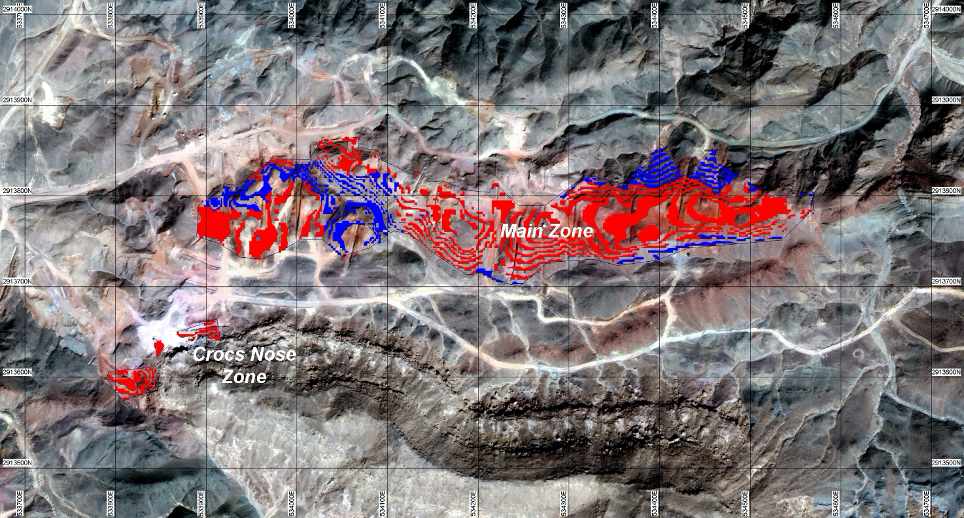Mineral Resource Estimate
The January 2017 maiden mineral resource estimate (“MMRE”) at Hamama West was completed by Cube Consulting (Perth, Western Australia), and is presented in Tables 1 and 2, using a gold price of $1250/oz.
| Weathering type | Tonnes | Au (g/t) | Ag (g/t) | AuEq (g/t) | Au (koz) | Ag (koz) | AuEq (koz) |
| Oxide & Transitional | 2,580,000 | 0.87 | 28.1 | 1.28 | 72 | 2,334 | 106 |
| Sulphide | 5,630,000 | 0.87 | 30.4 | 1.30 | 157 | 5,503 | 235 |
| Total | 8,210,000 | 0.87 | 29.7 | 1.29 | 230 | 7,836 | 341 |
Table 1: Inferred Mineral Resources at Hamama West
| Weathering type | Tonnes | Au (g/t) | Ag (g/t) | AuEq (g/t) | Au (koz) | Ag (koz) | AuEq (koz) |
| Sulphide | 3,805,000 | 0.72 | 27.6 | 1.12 | 88 | 3,376 | 137 |
Table 2: Indicated Mineral Resources at Hamama West
Since the completion of the MMRE additional diamond drilling and a comprehensive deep trenching and mechanical saw-cut channel sampling programme have been completed at Hamama West. Diamond drilling returned intersections including 40.0m @ 0.96 g/t Au and 24.0 g/t Ag (drillhole HAD-003), 22.2m @ 2.17 g/t Au and 41.9 g/t Ag (drillhole HAD-004), 48.5m @ 0.80 g/t Au and 15.5 g/t Ag (drillhole HAD-010), and 22.0m @ 0.87 g/t Au and 130 g/t Ag (drillhole HAD-012) from the Main Zone at Hamama West, and 28.0m @ 1.65 g/t Au and 82.7 g/t Ag (drillhole HAD-007) from the Crocs Nose Zone. None of these reported intersections were included in the January 2017 MMRE, and all increase the resource base at Hamama West above and beyond that quoted in the MMRE.
During late 2016 and early 2017 a re-sampling programme of the 2012 excavator-dug trenches at Hamama West was undertaken to assist in the construction of the Hamama West block model. The trenches were cleaned out and re-sampled from mechanically saw-cut channels over 1m intervals. Previously unreported surface channel sample intersections from this programme included 75m @ 1.84 g/t Au and 51.3 g/t Ag (trench HAT-117), 64m @ 3.26 g/t Au and 33.1 g/t Ag (trench HAT-096), 51m @ 3.39 g/t Au and 41.6 g/t Ag (trench HAT-104), and 45m @ 3.83 g/t Au and 49.8 g/t Ag (trench HAT-086) from the Hamama West Main Zone, and 25.4m @ 3.43 g/t Au and 8.7 g/t Ag (trench HAT-113) and 17m @ 3.10 g/t Au and 6.7 g/t Ag (trench HAT-143) from the Crocs Nose Zone. These intersections are deemed representative of the oxide mineralisation that outcrops at surface at Hamama West.

Outcrop of the Hamama West ore block model at surface (red: oxide, blue: transitional mineralisation)
Furthermore, surface trenching at Hamama East in 2018, approximately 1km to the east of Hamama West, has identified significant additional high-grade oxide mineralisation, with channel sampling returning intersections including 84m @ 1.13 g/t Au, 49.7 /t Ag and 7.29% Zn, 42.8m @ 1.28 g/t Au, 55.5 g/t Ag and 10.37% Zn and 33m @ 1.09 g/t Au, 51.1 g/t Ag and 2.14% Zn. This mineralisation has not been included in any resource estimation or modelling work to date. New drilling is planned to quantify the high-grade surface mineralisation in this area, with a view to further increasing the resource base at Hamama. First-pass drilling is also planned at the West Garida prospect, which has returned grab and channel samples assaying 99.6 g/t Au, 45.6 g/t Au and 17.45 g/t Au from a series of gold mineralised quartz veins mapped approximately about 3 km ENE of Hamama West.
A decision was made to evaluate the option of a starter open pit mine project to initially exploit the outcropping oxide and transitional mineral resource at Hamama West using HLP technology. A number of factors influenced this decision including the size of the maiden resource, the existence of the highest grade mineralisation outcropping at surface, the geometry of the oxide/transitional resource, the low capex/opex and short development period of the proposed HLP project, and the anticipated very low mining strip ratio and amenability of the mineralisation to HLP technology.
Aton envisages that starting mining at Hamama West with the development of the proposed starter open pit HLP project will allow the time and space to increase the overall resource base, including the Hamama West sulphide resource as well as other potential satellite deposits, and will lead to the development of the entire Hamama project area over a longer timeframe.
